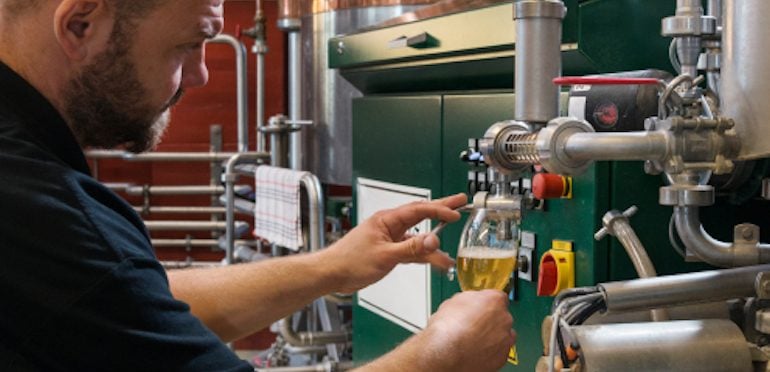How to Start a Craft Brewery
Understand the cost, location and your business goals before opening your own brewery.

Many, or all, of the products featured on this page are from our advertising partners who compensate us when you take certain actions on our website or click to take an action on their website. However, this does not influence our evaluations. Our opinions are our own. Here is a list of our partners and here's how we make money.
You’re with friends at your favorite craft brewery enjoying some tasty ales when it hits you: Why not turn your love of great beer into a profession and start your own brewery?
If you’re serious — and not just buzzed — understand that it takes a lot of planning, money and patience to make this dream a reality. Starting a small business is already difficult, and breweries are highly capital-intensive businesses that come with additional legal and permitting requirements.
But with sober planning, creative financing and tenacity, you could create your own neighborhood watering hole. Here’s some advice to get you started:
How much does equipment cost?
How much you’ll pay for brewing equipment ultimately depends on the size of your brewery and whether you buy new or used. You can purchase brewing equipment with the smallest capacity (1 barrel, which is 31 gallons of beer, equal to 320 12-ounce beers) for $100,000 or less if you buy it used, or pay up to $1 million or more for a brand-new, 30-barrel system (equal to 9,600 12-ounce beers), says Leonard Kolada, founder of Smokehouse Brewing Co. in Columbus, Ohio.
Your brewery needs essential equipment: kettles, kegs, boilers, bottling and canning lines, conveyors, cooling systems, storage tanks, fermentation tanks, filters and beer-labeling machines, piping and tubing, refrigeration equipment, cleaning equipment, waste treatment systems and tap handles.
Although you can get the cheapest equipment for reasonable prices, if you purchase equipment with less capacity and your brewery turns out to be a big success, you can run into problems because the system will be difficult and costly to modify, says Kolada, who recommends taking a more conservative approach when crafting your budget.
“If you’ve done your homework and details, and you think your project will cost extra, I would highly recommend that you up that by about 50%, just for the unforeseen, and see if your business plan would still work under that scenario,” Kolada says. Check out Nerdwallet’s best options for equipment financing.
Boost Your Credit for a Strong Future
As you grow your business, grow your options by building credit now. Better credit can make it easier to get financing so you can cover your needs. Our partner Kikoff can help you build credit faster starting at just $5 a month.¹

Location and construction
Of course, your brewery also needs a home. The monthly cost of rent depends heavily on your location and the size of the building. You may need to come up with the first month’s rent plus a security deposit for the landlord when you sign a lease. And you’ll also probably need to do construction on the building to get it fit for the brewery.
“You have to consider plumbing, electric needs, if the ceilings are high enough — you may have to tear out existing concrete slabs and re-pour them so the water drains properly — there’s a whole laundry list of things that goes into it,” says Kolada, who added that as a general rule of thumb, you should take your equipment costs and, double them, and that’s what you’re going to spend on construction for your building.
Rob Sama opened a 25,000-square-foot brewery in Chicago in spring 2016 called Baderbrau. He said the tricky part in starting a brewery is determining the right size and capacity.
“On the one hand, you have to plan for growth or you’ll get stuck,” Sama says, “but if you overbuild, you can end up with a monthly debt payment your sales don’t support.”
Although Sama is starting out with a 25,000-square-foot facility, he says the building will have 5,000 square feet of empty space for future fermentation tanks. “When you calculate costs, you need to calculate the costs of nonproductive floor space as well,” he says.
Other costs and issues
The cost of flooring is often overlooked, Sama says. A good composite floor that will withstand impact shock, temperature shock and acid from beer will cost upward of $10 per square foot, according to Sama.
“You will spill beer on the brewery floor when you’re brewing,” Sama says, “so if you have, say, a 100-barrel tank sitting there, you don’t want the cement underneath to erode away and have your tank topple over.”
Then there are the necessary permits and legal requirements. You’ll need to apply for a federal brewing permit with the Alcohol and Tobacco Tax and Trade Bureau. Although the application doesn’t cost anything, it’s usually takes four months to process, according to Matthew Cordell and Derek Allen, who have advised several startup breweries in North Carolina for legal firm Ward and Smith, P.A.
“The cost can range from several hundred dollars to several thousand,” Cordell says, “depending on how much work we have to do on our end.”
You can also turn to online legal services for advice and to save money.
Also, the government won’t approve your federal brewing permit until all of your equipment is installed and operational. That means you’ll have monthly expenses to pay before you even make and sell a drop of beer, Kolada says. So plan to have working capital to manage these ongoing expenses.
Local licensing is required if you want to serve beer at your brewery, including a state liquor license, which can take about 45 to 60 days to secure depending on the availability of state inspectors, says Matthew Pore, a senior manager with Baker Newman Noyes’s tax division.
Brewers may also want to file for a retailer license if they want to sell other products like clothing or supplies at their brewery, Pore says.
You’ll also need to choose a business structure. Will your business be a limited liability company or a corporation? Cordell recommends filing as an LLC as it’s “slightly quicker, cheaper and easier than a corporation.” He also recommends having an operating agreement as part of the LLC.
“An operating agreement says how the business is going to be run, who’s going to control it, how new investors will be brought in and how to resolve disputes,” Cordell says.
What about insurance? Any manufacturer of beer should have property, casualty and liability insurance, and a bank won’t lend to you unless you have all three, according to Allen. To get your federal brewer’s permit, you’ll also be required to get a brewer’s bond, which ensures you pay your federal taxes.
How to finance the startup costs
So where can you get the money?
Friends, family and inner networks: This is the most popular route for first-time brewers seeking finance, according to Kolada. “Just go to those you know best, show enthusiasm and talk people out of their money,” he says. Here are some dos and don’ts of asking family and friends for startup capital.
Home equity loan: If you have substantial equity in your home or other real estate, taking out a home equity loan or line of credit is one potential source of funds.
Retirement accounts: Tapping into 401(k)s and individual retirement accounts (IRAs) to fund your brewery can be a risky strategy, as you are putting your retirement funds at risk. You’ll also face fees and taxes. The IRS allows a financing strategy known as a Rollover as Business Start-Up to avoid taxes and penalties, but the transaction is fairly complex, so hiring a professional is likely a smart move.
Reward crowdfunding: This is the process of raising small amounts of money online from a large group of individuals, in support of a project or venture. Popular crowdfunding websites include Kickstarter, Indiegogo, GoFundMe and Crowdrise.
Equity crowdfunding: This type of crowdfunding is similar to reward crowdfunding, except you are giving up a percentage of ownership in your company instead of rewards.
Once you’re up and running, many more financing opportunities become available to you: SBA loans are a low-cost option, and online lenders can be a good alternative for small-business loans and lines of credit when you need cash quickly or can’t qualify for a traditional loan.
Tips for brewery startups
“It’s very cliché to say go follow your passions,” Sama says. “You have to make sure your passions are something that meet a demand in the marketplace.”
New brewery owners should be prepared to put a lot of money back into their business, even after reaching profitability, according to Kolada.
“It’s not a get-rich-quick scheme,” he says. “It’s very capital-intensive and could go on for years where you’re putting more money into it, not because you’re unprofitable but because as demand increases you have to buy more equipment.”
Even though the process takes patience, money and focus, Kolada says it could be worth all the blood, sweat and tears in the end.
“If your beer is great, ultimately it will work out,” he says, “but it’s a lot of work. Having said that, it’s still really cool.”

